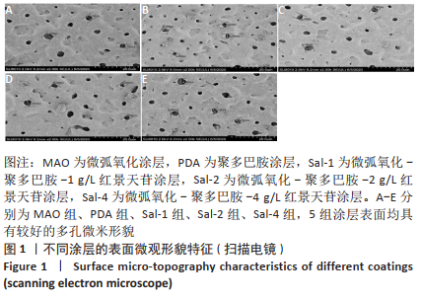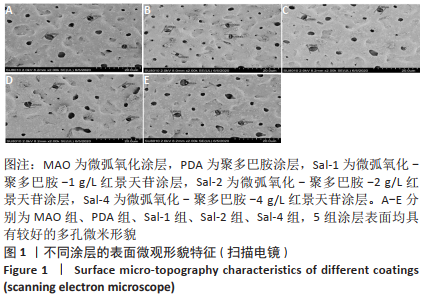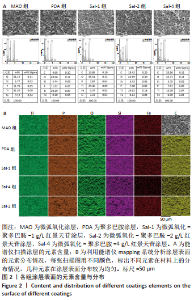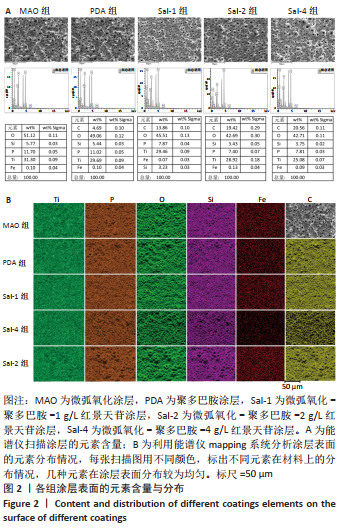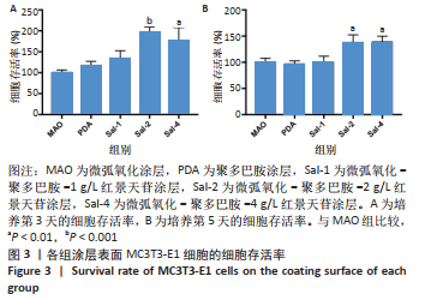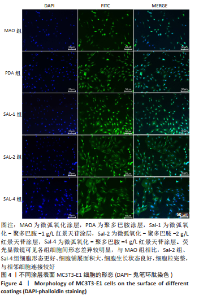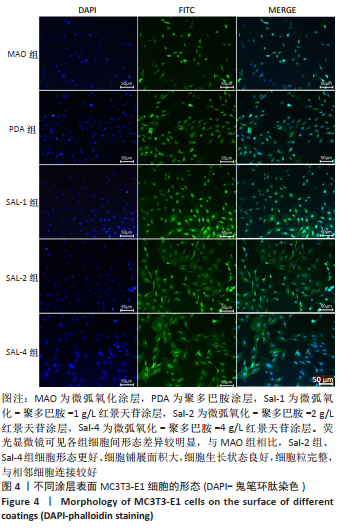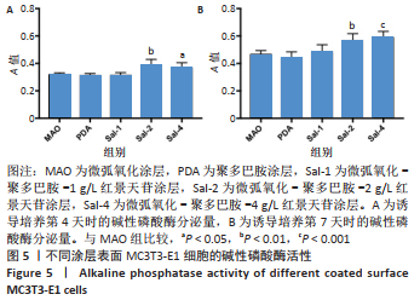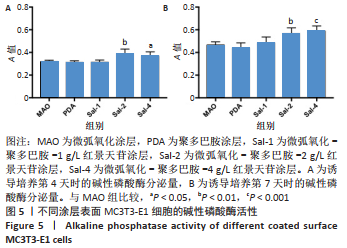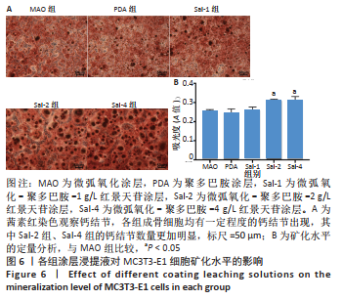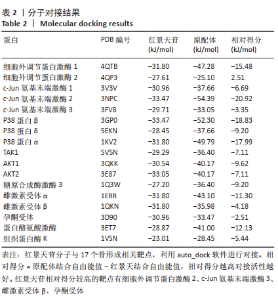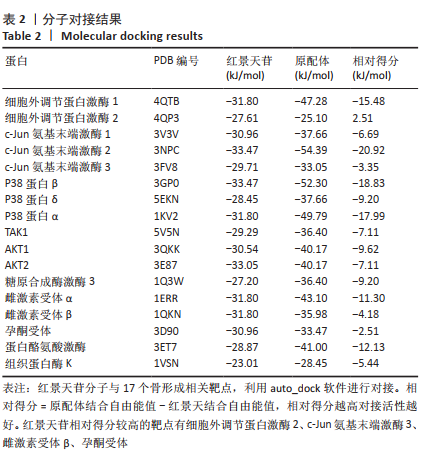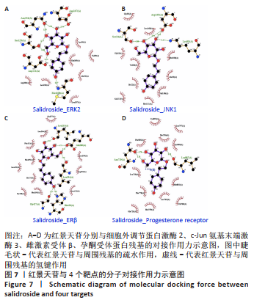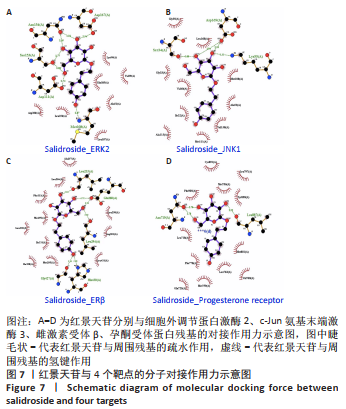Chinese Journal of Tissue Engineering Research ›› 2022, Vol. 26 ›› Issue (10): 1522-1529.doi: 10.12307/2022.198
Previous Articles Next Articles
Polydopamine assisted salidroside to improve bone formation on micro-arc oxidation of pure titanium
Liang Pengchen1, 2, 3, Shi Junfeng2, 4, Sun Miaomiao1, 2, Liang Dongyu2, 3, Sha Shuang2, 5, Yi Qingqing2, 3, Chang Qing1, 2
- 1Graduate School, Shanghai University of Traditional Chinese Medicine, Shanghai 200120, China; 2Shanghai Engineering Research Center of Advanced Dental Technology and Materials, Shanghai Ninth People’s Hospital, College of Stomatology, Shanghai Jiao Tong University School of Medicine, Shanghai 200011, China
-
Received:2020-10-04Revised:2020-10-12Accepted:2020-11-19Online:2022-04-08Published:2021-10-25 -
Contact:Chang Qing, MD, Associate researcher, Graduate School, Shanghai University of Traditional Chinese Medicine, Shanghai 200120, China; Shanghai Engineering Research Center of Advanced Dental Technology and Materials, Shanghai Ninth People’s Hospital, College of Stomatology, Shanghai Jiao Tong University School of Medicine, Shanghai 200011, China -
About author:Liang Pengchen, Master candidate, Graduate School, Shanghai University of Traditional Chinese Medicine, Shanghai 200120, China; Shanghai Engineering Research Center of Advanced Dental Technology and Materials, Shanghai Ninth People’s Hospital, College of Stomatology, Shanghai Jiao Tong University School of Medicine, Shanghai 200011, China; Clinical Research Center, Jiading District Central Hospital Affiliated to Shanghai University of Medicine & Health Sciences, Shanghai 201800, China -
Supported by:he National Natural Science Foundation of China, No. 81670968 (to CQ); Key Project of Shanghai Jiading District Health Commission, No. 2020-ZD-03 (to CQ); the Natural Science Foundation of Jiading District of Shanghai, No. JDKW-2020-0013 (to YQQ)
CLC Number:
Cite this article
Liang Pengchen, Shi Junfeng, Sun Miaomiao, Liang Dongyu, Sha Shuang, Yi Qingqing, Chang Qing. Polydopamine assisted salidroside to improve bone formation on micro-arc oxidation of pure titanium[J]. Chinese Journal of Tissue Engineering Research, 2022, 26(10): 1522-1529.
share this article
Add to citation manager EndNote|Reference Manager|ProCite|BibTeX|RefWorks
| [1] NARITA K, NIINOMI M, NAKAI M. Effects of micro- and nano-scale wave-like structures on fatigue strength of a beta-type titanium alloy developed as a biomaterial. J Mech Behav Biomed Mater. 2014;29: 393-402. [2] DHIVYA S, AJITA J, SELVAMURUGAN N. Metallic Nanomaterials for Bone Tissue Engineering. J Biomed Nanotechnol. 2015;11(10):1675-700. [3] SHABALOVSKAYA S, ANDEREGG J, HUMBEECK JV. Critical overview of Nitinol surfaces and their modifications for medical applications. Acta Biomater. 2008;4(3):447-467. [4] LIU X, CHU PK, DING C. Surface modification of titanium, titanium alloys, and related materials for biomedical applications. Mater Sci Eng R Rep. 2004; 47(3-4):49-121. [5] 梁鹏晨,李路易,常庆,等.微弧氧化技术在骨科钛植入体生物功能改性中的应用进展[J].中国医学物理学杂志,2019,36(11): 1335-1341. [6] BALASUNDARAM G, WEBSTER TJ. A perspective on nanophase materials for orthopedic implant applications. J Mater Chem A. 2006; 16(38):3737-3745. [7] WEBSTER TJ, ERGUN C, DOREMUS RH, et al. Enhanced functions of osteoblasts on nanophase ceramics. Biomaterials. 2000;21(17): 1803-1810. [8] AKIN FA, ZREIQAT H, JORDAN S, et al. Preparation and analysis of macroporous TiO2 films on Ti surfaces for bone-tissue implants. J Biomed Mater Res A. 2001;57(4):588-596. [9] WANG Q, HU H, QIAO Y, et al. Enhanced Performance of Osteoblasts by Silicon Incorporated Porous TiO2 Coating. J Mater Sci Technol. 2012;28(2): 109-117. [10] LIU Y, AI K, LU L. Polydopamine and its derivative materials: synthesis and promising applications in energy, environmental, and biomedical fields. Chem Rev. 2014;114(9):5057-5115. [11] KANG SM, HWANG NS, YEOM J, et al. One-Step Multipurpose Surface Functionalization by Adhesive Catecholamine. Adv Funct Mater. 2012; 22(14):2949-2955. [12] LEE SJ, LEE D, RIM YOON TR, et al. Surface modification of 3D-printed porous scaffolds via mussel-inspired polydopamine and effective immobilization of rhBMP-2 to promote osteogenic differentiation for bone tissue engineering. Acta Biomater. 2016;40:182-191. [13] ZHANG JK, YANG L, MENG GL, et al. Protection by Salidroside against Bone Loss via. Inhibition of Oxidative Stress and Bone-Resorbing Mediators. PLoS One. 2013;8(2):e57251. [14] 梅国华,郭小芹,陈京京,等.红景天苷对成骨细胞的作用及相关分子机制研究[J].口腔医学研究,2017(9):9-12. [15] 祁琳,王川,陈雨萌,等.红景天苷对新生大鼠颅骨成骨细胞增殖、分化及矿化的调节作用[J].武警后勤学院学报(医学版),2019, 28(3):12-17. [16] LIU W, LI T, YANG C. Lithium-Incorporated Nanoporous Coating Formed by Micro Arc Oxidation (MAO) on Magnesium Alloy with Improved Corrosion Resistance, Angiogenesis and Osseointegration. J Biomed Nanotechnol. 2019;15(6):1172. [17] ZHOU Y, QIAN M, LIANG Y, et al. Effects of Leukemia Inhibitory Factor on Proliferation and Odontoblastic Differentiation of Human Dental Pulp Cells. J Endod. 2011;37(6):819-824. [18] 孙静.蛇床子素促成骨作用及代谢多态性研究[D].天津:天津医科大学, 2019. [19] HSIN K, MATSUOKA Y, ASAI Y, et al. SystemsDock:a web server for network pharmacology based prediction and analysis. Nucleic Acids Res. 2016;44(W1):W507-W513. [20] 梁鹏晨,周紫艳,孙苗苗,等.鄂版肺炎1号方治疗新型冠状病毒肺炎的生物信息学研究[J].上海中医药杂志,2020,54(9):1-8,19. [21] TROTT O, OLSON AJ. AutoDock Vina: Improving the speed and accuracy of docking with a new scoring function, efficient optimization, and multithreading. J Comput Chem. 2010;31(2):455-461. [22] LIU H, LI W, LUO B, et al. Icariin immobilized electrospinning poly(L-lactide) fibrous membranes via polydopamine adhesive coating with enhanced cytocompatibility and osteogenic activity. Mater Sci Eng C Mater Biol Appl. 2017;79:399-409. [23] YU F, CHEN S, CHEN Y, et al. Experimental and theoretical analysis of polymerization reaction process on the polydopamine membranes and its corrosion protection properties for 304 Stainless Steel. J Mol Struct. 2010;982(1-3):152-161. [24] JIANG J, ZHU L, LI X, et al. Surface modification of PE porous membranes based on the strong adhesion of polydopamine and covalent immobilization of heparin. J Membr Sci. 2010;364(1): 194-202. [25] CHEN S, CHEN Y, LEI Y, et al. Novel strategy in enhancing stability and corrosion resistance for hydrophobic functional films on copper surfaces. Electrochem Commun. 2009;11(8):1675-1679. [26] LEE JJ, PARK IS, SHIN GS, et al. Effects of polydopamine coating on the bioactivity of titanium for dental implants. Int J Precis Eng Manuf. 2014; 15(8):1647-1655. [27] SU L, YU Y, ZHAO Y, et al. Strong Antibacterial Polydopamine Coatings Prepared by a Shaking-assisted Method. Sci Rep. 2016;6(1):24420-24420. [28] SHISHU H, NUANYI L, YANG H, et al. Polydopamine-Assisted Surface Modification for Bone Biosubstitutes. Biomed Res Int. 2016;2016: 2389895. [29] 沈佳丽,石畅,施冬健,等.多巴胺对骨修复材料表面改性的研究进展[J].材料导报,2017,31(21):54-61. [30] ZHANG T, ZHOU W, JIA Z, et al. Polydopamine-assisted functionalization of heparin and vancomycin onto microarc-oxidized 3D printed porous Ti6Al4V for improved hemocompatibility, osteogenic and anti-infection potencies. Sci China Mater. 2018;61(4):579-592. [31] POH CK, SHI Z, LIM TY, et al. The effect of VEGF functionalization of titanium on endothelial cells in vitro. Biomaterials. 2010;31(7): 1578-1585. [32] LEE JS, LEE JC, HEO JS. Polydopamine-assisted BMP-2 immobilization on titanium surface enhances the osteogenic potential of periodontal ligament stem cells via integrin-mediated cell-matrix adhesion. J Cell Commun Signal. 2018;12(4):661-672. [33] YING Y, LUO J. Salidroside promotes human periodontal ligament cell proliferation andosteocalcin secretion via ERK1/2 and PI3K/Akt signaling pathways. Exp Ther Med. 2018;15(6):5041-5045. [34] 占跃晨,张立鹏,毛根祥,等.红景天苷调节人成骨肉瘤细胞MG63成骨分化及相关信号的研究[J].中国医药生物技术,2013,8(6): 414-419. [35] GUO XQ, QI L, YANG J, et al. Salidroside accelerates fracture healing through cell-autonomous and non-autonomous effects on osteoblasts. Cell Tissue Res. 2017;367(2):197-211. [36] SONG J, JIN P, LI M, et al. Antibacterial properties and biocompatibility in vivo and vitro of composite coating of pure magnesium ultrasonic micro-arc oxidation phytic acid copper loaded. J Mater Sci Mater Med. 2019;30(5):1-14. [37] 申婷婷.钛植入体表面乳铁蛋白复合涂层的制备及其生物学评价[D].重庆:重庆大学,2018. [38] CHEN JJ, ZHANG NF, MAO GX, et al. Salidroside stimulates osteoblast differentiation through BMP signaling pathway. Food Chem Toxicol. 2013;62:499-505. [39] JAISWAL RK, JAISWAL N, BRUDER SP, et al. Adult human mesenchymal stem cell differentiation to the osteogenic or adipogenic lineage is regulated by mitogen-activated protein kinase. J Biol Chem. 2000; 275(13): 9645-9652. [40] 张波,耿彬,谭小义,等.MAPK信号通路与骨质疏松关系的研究进展[J].中国矫形外科杂志,2014,22(23):2161-2164. |
| [1] | Dai Xianglin, Zhang Wenfeng, Yao Xijun, Shang Jiaqi, Huang Qiujin, Ren Yifan, Deng Jiupeng. Barium titanate/polylactic acid piezoelectric composite film affects adhesion, proliferation, and osteogenic differentiation of MC3T3-E1 cells [J]. Chinese Journal of Tissue Engineering Research, 2023, 27(3): 367-373. |
| [2] | Liu Huan, Li Han, Ma Yunhao, Zhong Weijian, Ma Guowu. Osteogenic capacity of partially demineralized dentin particles in the maxillary sinus lift [J]. Chinese Journal of Tissue Engineering Research, 2023, 27(3): 354-359. |
| [3] | Li Rui, Liu Zhen, Guo Zige, Lu Ruijie, Wang Chen. Aspirin-loaded chitosan nanoparticles and polydopamine modified titanium sheets improve osteogenic differentiation [J]. Chinese Journal of Tissue Engineering Research, 2023, 27(3): 374-379. |
| [4] | Wu Lihao, Shao Anliang, Xu Lin, Ren Kang, Wang Hongjian, Chen Liang, Xu Ling. Evaluation of immunotoxicity of the absorbable macroporous polysaccharides composite hemostatic material [J]. Chinese Journal of Tissue Engineering Research, 2023, 27(3): 329-334. |
| [5] | Bi Jintong, Hu Xin, Liu Jinshu. Wear properties of dental ceramics [J]. Chinese Journal of Tissue Engineering Research, 2023, 27(3): 406-412. |
| [6] | Jiang Haifang, Liu Rong, Hu Peng, Chen Wei, Wei Zairong, Yang Chenglan, Nie Kaiyu. Application of 3D printing technology in the precise and personalized treatment of cleft lip and palate [J]. Chinese Journal of Tissue Engineering Research, 2023, 27(3): 413-419. |
| [7] | Zhao Yuwei, Gao Yuting, Li Zhen, Hao Huiqin . Mechanism of Ermiao San in the treatment of rheumatoid arthritis [J]. Chinese Journal of Tissue Engineering Research, 2022, 26(5): 742-748. |
| [8] | Yang Feng, Zhao Qian, Zhang Shixuan, Zhao Tienan, Feng Bo. Effectiveness and safety of rapamycin combined with CD133 antibody stent in preventing vascular restenosis [J]. Chinese Journal of Tissue Engineering Research, 2022, 26(4): 579-584. |
| [9] | Chen Xiaoxu, Luo Yaxin, Bi Haoran, Yang Kun. Preparation and application of acellular scaffold in tissue engineering and regenerative medicine [J]. Chinese Journal of Tissue Engineering Research, 2022, 26(4): 591-596. |
| [10] | Shen Song, Xu Bin. Diffuse distribution of bone cement in percutaneous vertebroplasty reduces the incidence of refracture of adjacent vertebral bodies [J]. Chinese Journal of Tissue Engineering Research, 2022, 26(4): 499-503. |
| [11] | Hou Wanxing, Li Hongwei, Zheng Xin, Zhu Xianren. Correlation between preoperative magnetic resonance imaging findings and bone cement leakage after percutaneous vertebral augmentation [J]. Chinese Journal of Tissue Engineering Research, 2022, 26(4): 504-509. |
| [12] | Yang Sidi, Wang Qian, Xu Nuo, Wang Ronghan, Jin Chuanqi, Lu Ying, Dong Ming. Biodentine enhances the proliferation and differentiation of osteoblasts through upregulating bone morphogenetic protein-2 [J]. Chinese Journal of Tissue Engineering Research, 2022, 26(4): 516-520. |
| [13] | Le Guoping, Zhang Ming, Xi Licheng, Luo Hanwen. Preparation and in vitro evaluation of vancomycin hydrochloride@polylactic acid-glycolic acid copolymer-chitosan-hyaluronic acid composite sustained-release microspheres [J]. Chinese Journal of Tissue Engineering Research, 2022, 26(4): 528-534. |
| [14] | Liu Tongbin, Lin Peng, Zhang Xiaoming, Dong Xiling, Cao Fei, Wang Le, Guo Xinxing. Optimization of preparation method of atorvastatin calcium sustained-release microspheres [J]. Chinese Journal of Tissue Engineering Research, 2022, 26(4): 535-539. |
| [15] | Qiu Peng, Fu Qilin, Liu Min, Lan Yuyan, Wang Pin. Comparison of oral micro-adhesion on polyetheretherketone, zirconium dioxide, and pure titanium abutment [J]. Chinese Journal of Tissue Engineering Research, 2022, 26(4): 540-545. |
| Viewed | ||||||
|
Full text |
|
|||||
|
Abstract |
|
|||||
